An RV worm gear reducer is a highly efficient and compact mechanical component used widely in automation, robotics, CNC machinery, and various industrial applications. It plays a crucial role in reducing the speed and increasing the torque of a motor, making it suitable for high-precision and high-load tasks. But what sets the RV worm gear reducer apart from other types of gear reducers? Let’s explore its core advantages.
1. High Torque Density
One of the most significant advantages of RV worm gear reducers is their high torque output relative to their compact size. This is due to their unique internal structure, often consisting of a double cycloidal gear mechanism in RV models (particularly in robotic RV reducers) or a combination of worm and gear designs. These mechanisms allow the RV reducer to handle large loads while maintaining a relatively small footprint. This makes them ideal for applications where space is limited but performance demands are high.
2. Excellent Positioning Accuracy
RV gear reducers are known for their minimal backlash—often less than 1 arc-minute—which makes them extremely suitable for precision-driven tasks such as robotic arms, automated assembly lines, and CNC machines. Reduced backlash means less lost motion during direction changes, resulting in more accurate and repeatable movements.
3. High Shock Load Capacity
Thanks to their robust internal construction, RV worm gear reducers can withstand shock loads up to five times their rated torque. This is especially valuable in industrial and automation settings where machines may be exposed to sudden starts, stops, or unexpected force impacts. The durability of these reducers ensures longer life and fewer maintenance requirements.
4. Compact and Lightweight Design
Despite their ability to handle large torque loads, RV worm gear reducers are designed to be compact and relatively lightweight. This is especially important in robotic and mobile applications, where reducing the total system weight improves energy efficiency and system responsiveness. The space-saving nature of RV reducers also allows for more design flexibility in complex machinery layouts.
5. Quiet and Smooth Operation
RV worm gear reducers operate smoothly and with less noise compared to other types of reducers, especially under high loads. The internal design of the gears reduces friction and vibration, resulting in a quieter working environment and less wear on connected components. This is crucial in environments like medical equipment, semiconductor manufacturing, and automated inspection systems.
6. High Efficiency at Low Speed
Worm gear reducers traditionally have lower efficiency than other types at high speed due to friction losses, but RV designs mitigate this through improved gear engagement and optimized construction. In low-speed applications, especially where constant torque is required, RV worm gear reducers offer excellent performance with high mechanical efficiency.
7. Versatile Mounting and Integration
Another advantage is the flexibility in mounting and integration. RV worm gear reducers can be installed in various orientations and easily integrated with servo motors, stepper motors, or AC motors. This adaptability allows designers to use them in a wide range of machinery without being limited by alignment or space constraints.
In conclusion, the RV worm gear reducer offers a blend of compactness, strength, precision, and durability that makes it a preferred choice in modern automation and robotics. Whether you're designing a robotic arm, an industrial manipulator, or a precision CNC system, the RV reducer brings clear mechanical and performance benefits that are hard to match with traditional gear systems.


 English
English русский
русский bahasa Indonesia
bahasa Indonesia
